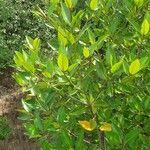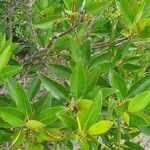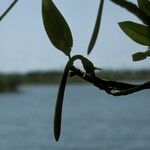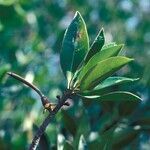Tree to 25 m high, often with several trunks; bark black, often with pale horizontal and vertical stripes, especially near base. Leaves elliptic or broadly lanceolate, dark green and shiny above, paler below, not spotted; lamina 8–19 cm long, 4–9 cm wide; petiole 1–4 cm long. Inflorescence usually 2-flowered and borne below oldest leaves; peduncle 5–15 mm long, 5 mm wide, slightly flattened; pedicels very short; bracteoles completely united into a bulbous cup with brown, cork-like, longitudinal fissures in upper half. Petals 8–11 mm long, glabrous, membranous, not involute. Stamens usually 11 or 12; anthers 6–8 mm long, sessile. Upper part of ovary shallowly conical, 1.5–2.5 mm high; style 0.5–1 mm long; stigma 2-lobed. Fruit rough, pyriform, usually 2–2.5 cm long. Hypocotyl 20–40 cm long, club-shaped.
Trees or shrubs, 3-6(-10) m tall. Bark gray, usually with vertical fissures. Stipules 4-8 cm. Petiole 1.5-3 cm, usually tinged reddish; leaf blade elliptic-oblong to sublanceolate, 7-16 × 3-6 cm, abaxial midvein reddish, base broadly cuneate, apex acute to apiculate. Inflorescences 2-flowered cymes; peduncle 0.7-10 mm. Flowers sessile. Calyx lobes ovate, concave, 1-1.4 cm, apex acute. Petals lanceolate, flat, 6-8 mm, membranaceous, glabrous, white. Stamens mostly 12, 4 adnate to base of petals, 8 adnate to sepals, 6-7.5 mm; anthers nearly sessile, apex apiculate. Ovary largely enclosed by disk, free part 1.5-2.5 mm; style ca. 1 mm. Fruit ca. 2.5 × 1.5 cm, apical half narrower. Hypocotyl cylindric-clavate, ca. 3.8 × 1.2 cm, ± blunt before falling. Fl. and fr. all year.
A medium height straight tree. It grows up to 5-12 m tall. It usually has prop roots covered with breathing pores. The leaves are dark green and not rolled at the edge. They are somewhat dull on top and twice as long as wide and end in a sharp tip. The leaves can be 8-19 cm long and 4-9 cm wide. The flowers are in pairs or short stalks. They are cream and 1.5 cm long. The flowers normally occur as 2 together below the oldest leaves. The fruit are relatively small 21 mm wide. The hypocotyl is green and about 280 mm long with a blunt tip.





